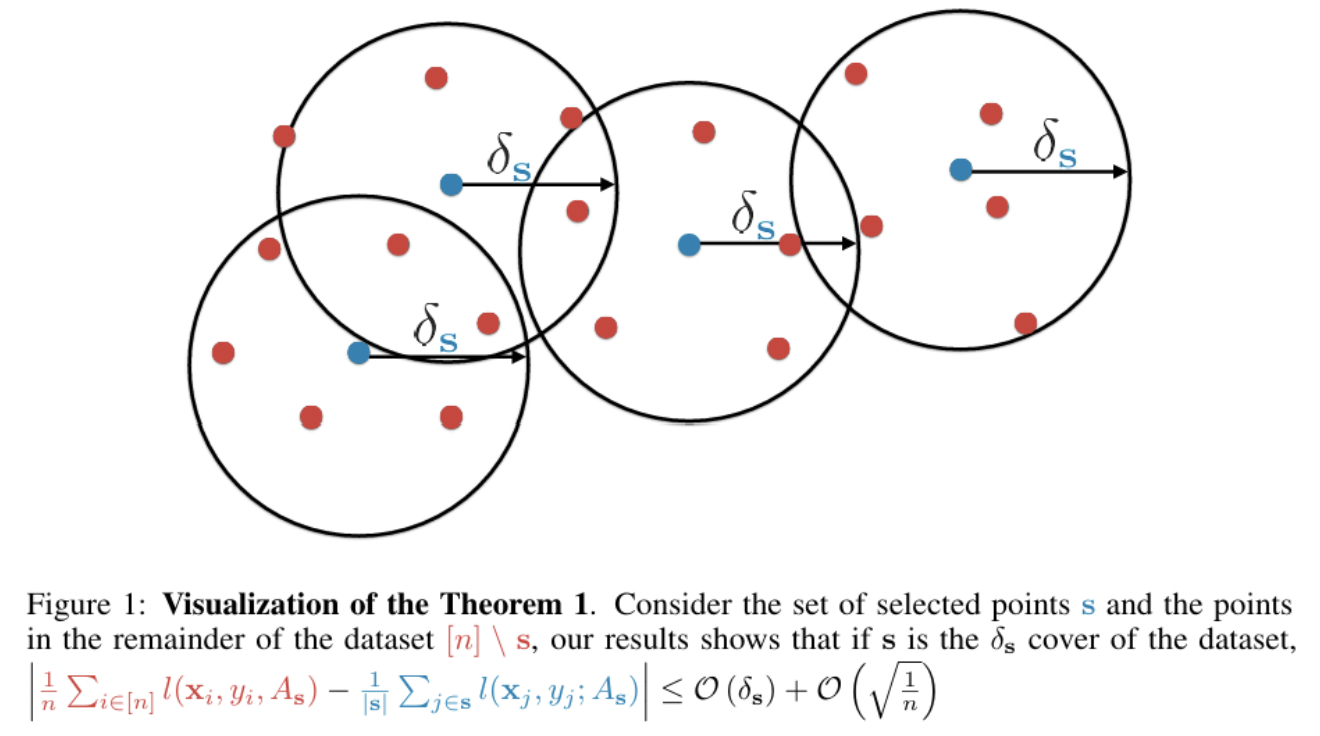Active Learning (AL)
1. Introduction
-
배경: 높은 Labeling 비용
-
아이디어: Unlabeled data 중, labeling을 할 데이터를 능동적으로 선택
-
주요 특징 및 개념
-
Label Efficiency: 모든 데이터를 라벨링하지 않고도 성능 향상 가능.
-
Query Strategy: 모델이 가장 정보가 될 만한 데이터를 “질문”해서 라벨을 요청.
-
Iteration: 모델 학습 → informative sample 선택 → 라벨 요청 → 학습 반복.
-
2. 주요 쿼리 전략 (Query Strategies)
- Uncertainty Sampling
- 모델이 가장 불확실해하는 샘플 선택 (e.g., 가장 낮은 softmax confidence)
- Query by Committee (QBC)
- 여러 모델로 구성된 committee 간 예측 불일치가 큰 샘플 선택
- Expected Model Change / Expected Error Reduction
- 어떤 샘플을 학습하면 성능이 얼마나 향상될지를 예측하여 선택
- Core-set Approaches
- 데이터 분포 전체를 대표할 수 있는 샘플 집합 선택
3. Core-set & Diversity-based
기본 아이디어
데이터 전체를 잘 대표하는 샘플(대표성, representativeness)과 다양한 분포 영역에서 골고루 선택된 샘플(다양성, diversity)을 선택!
i.e., “가장 혼란스러운 샘플”이 아니라, “라벨링을 통해 가장 많은 영역을 커버할 수 있는 샘플은 무엇인가?”
(1) k-Center Greedy Algorithm
- https://arxiv.org/pdf/1708.00489
Sener, Ozan, and Silvio Savarese. "Active learning for convolutional neural networks: A core-set approach." arXiv preprint arXiv:1708.00489 (2017).
핵심 아이디어: 현재 라벨된 데이터가 잘 커버하지 못한 영역을 우선 탐색
-
Procedure
-
Step 1) Feature 추출
-
Unlabeled 데이터 전체에 대해 feature embedding을 계산
(e.g., CNN의 마지막 pooling layer 또는 projection head를 사용)
-
\(f(x) \in \mathbb{R}^d\).
-
-
Step 2) 초기 Core-set 구축
- 라벨된 데이터들의 feature \(\mathcal{L} = \{ f(x_i) \}\)
-
Step 3) Distance 계산
-
각 unlabeled 샘플 u에 대해:
\(d(u, \mathcal{L}) = \min_{l \in \mathcal{L}} \mid \mid f(u) - f(l) \mid \mid_2\).
-
- Step 4) 가장 먼 샘플 선택
- \(\max_{u \in \mathcal{U}} d(u, \mathcal{L})\).
- 선택된 샘플을 Core-set에 추가 & 반복
- K개 샘플 선택 완료 시 종료
-
-
장/단점
-
장점: 다양한 분포 영역을 고르게 커버
-
단점:
- 모든 pairwise 거리 계산 필요 → 계산 비용 높음 \(\mathcal{O}(N \times k)\)
- feature embedding의 품질에 의존적
-

(2) Clustering-based
- https://proceedings.mlr.press/v16/bodo11a/bodo11a.pdf
Bodó, Zalán, Zsolt Minier, and Lehel Csató. "Active learning with clustering." Active Learning and Experimental Design workshop In conjunction with AISTATS 2010. JMLR Workshop and Conference Proceedings, 2011.
핵심 아이디어: 데이터를 clustering & 각 cluster의 중심을 선택
-
Procedure
-
Step 1) 모든 unlabeled 데이터에 대해 embedding 추출
-
Step 2) Clustering
-
Step 3) For each cluster …
-
Centroid에 가까운 샘플 1개 선택
( 혹은 entropy, uncertainty, 거리 기준으로 top-k 선택 )
-
-
-
기타: 각 cluster 크기 비례로 sample 수 조절
-
장/단점
-
장점:
-
라벨링 샘플의 분포 균형 확보
-
소수 클래스 영역도 잘 탐색 가능
-
semi-supervised AL에 적합 (pseudo-label + cluster)
-
-
단점:
- cluster 수 설정 어려움
-
4. 코드
k-Center Greedy Algorithm 예시
import torch
import numpy as np
def compute_coreset_indices(embeddings_labeled, embeddings_unlabeled, k):
selected = []
dist = torch.cdist(embeddings_unlabeled, embeddings_labeled).min(dim=1).values
for _ in range(k):
idx = torch.argmax(dist)
selected.append(idx.item())
new_point = embeddings_unlabeled[idx].unsqueeze(0)
dist = torch.minimum(dist, torch.cdist(embeddings_unlabeled, new_point).squeeze(1))
return selected
